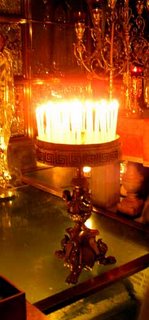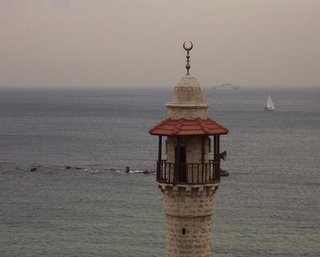New travels in a new part of the old world. The year 2006 begins for me in the Levant: for the next few weeks I will be in Israel, Palestine and Jordan, and then Turkey for a week before returning to New York. During this trip I will not be doing any performances or attending any writers’ festivals, and I will not be promoting myself except in the sense that I have to impress my girlfriend’s family as a decent and responsible young man. Therefore this record is purely for the sake of conveying a few observations to some of you who may be interested. Shalom!
If you are making plans for next year, my advice is that there are probably more exciting places to spend New Year’s Eve than Tel Aviv. The Jewish New Year begins in September with Rosh Hashanah, so while January 1st is recognized, it is generally not made a big deal of here. And since New Year’s Eve falls this year on a Saturday night (the end of the Sabbath and the end of the weekend), it means that the following day is a working day. So Karen and her mother Ronit and her mother’s boyfriend Alex and I went out to a café and had some hot cider, and at midnight (or thereabouts, nobody was really watching the clock) we cheered for ten seconds or so and then went back to drinking our cider. It was the café owner’s birthday on the 1st, so that livened things up a bit.
Afterwards, we walked along the waterfront to check out what was going on at the clubs there, and I dipped my fingers in the Mediterranean. It was easily warm enough to swim in, if you’re used to the North Atlantic, although when I said so the others seemed to think I was crazy. When Alex arrived to pick us up earlier, he had brought a winter coat for me because he thought I’d be too cold. And he seriously urged me to wear it, even though it was barely below room temperature outside and I was feeling overdressed in my cardigan. Later we took a drive through Jaffa and got some Israeli bagels at an all-night bakery (they resemble Montreal bagels more than New York bagels, by the way).
I was happy for the mild weather because over the Christmas break in the Maritimes I had come down with a cold, which I had to put up with during a 16-hour drive through a snowstorm back to the US, and then during two flights and our 12-hour layover in Amsterdam which almost turned into a 36-hour layover because of another snowstorm, which landed with perfect timing on the runway we’d been planning to use to take off. It was an exhausting few days, so when we arrived at Karen’s grandmother’s place in Holon (on the outskirts of Tel Aviv), we were happy to spend a couple of days sleeping and doing nothing more adventurous than walking to the mall. Also, I’ve been practicing what I’ve learned in my Beginner’s Hebrew book, which is basically how to read the Hebrew aleph-bet (even though so far I don’t usually understand the words I’m reading). I felt quite proud of myself for being able to tell the difference between shampoo and conditioner just by reading the labels.

Yesterday we went to Jerusalem, where I started to feel a little more genuinely touristy. It was pretty easy to feel that way, walking among the souvenir shops and being invited to buy everything from crucifixes and menorahs to small plush camels to jelly doughnuts to weird slogan t-shirts (one had an image of a jet-fighter and said “US, Don’t worry. Israel is right behind you.”) More surreal for me were the crowds of off-duty soldiers, most in their late teens, wearing jeans and sweatshirts and toting automatic rifles over their shoulders. All young Israelis, male and female, must serve in the army, and one of the first rules is that you never leave your rifle. I think that the young soldiers are routinely taken on tours of Jerusalem, I suppose to give them a clear sense of what it is they are protecting, and I saw lots of them getting their pictures taken in front of the Western Wall, Judaism’s holiest site.
Being in Jerusalem certainly gives one the sense that something is at stake: it has been the stage for sieges, battles, massacres, crusades, martyrdoms, destruction and reconstruction for basically as long as it has been a city, which is about 3000 years. The history of conquest by one tribe after another, including the founding events of three major religions, is all a bit overwhelming, and I had a hard time keeping the Jebusites and Seleucids and Maccabeans all straight. The information on the city’s history given in the Tower of David museum also focuses disproportionately, as is to be expected, on the history of the Jews in Jerusalem. But walking through the narrow corridors of the Old City, your feet sometimes fall on stones laid down by the Romans two millennia ago, and you hear conversation and see signs in Hebrew, Arabic, English and half a dozen other European languages, and it’s hard to ignore that this is a very important place for very many people.
Aside from that, it is a remarkably beautiful city, even in the newer parts. A local bylaw dictates that all buildings must be constructed of Jerusalem stone, and the uniform cream-coloured houses are clustered amid slender cypress trees on the tops of hills as far as you can see. We spent the afternoon at the museum, wandering, and visiting the Western Wall and the Church of the Holy Sepulchre, which was supposedly built on the site where Jesus was crucified and then buried. This is one of the strangest and creepiest buildings I think I’ve ever been in: centuries of history have made it an architectural anomaly, a Byzantine hodge-podge, and despite its hordes of visitors, no effort is made to modernize or even to signpost its somber – I suppose the right word would be sepulchral – tunnels and grottoes. Most of the lighting is bare hanging bulbs and candles. Stepping among the other photo-taking, floor-kissing pilgrims, I took this shot of the glass-covered stone which is purported to be the crest of the hill of the crucifixion.

There is a lot to see in Jerusalem, and we intend to return next week (it’s less than an hour from Tel Aviv) to spend more time. We will also rent a car there and drive south to visit the Dead Sea (where I will float on the surface of the lowest body of water in the world, no matter what the temperature is) and the Negev desert (where we will go hiking with Karen’s cousin who is a tour guide) before continuing on to sunny Eilat on the Red Sea. First, though, on Thursday we’re going north to Haifa where Karen’s aunt and uncle will meet us and bring us to Nazareth. They intend to take us on an off-road adventure in their 4x4, during which I am told we will spend the night in a Bedouin tent. Also, we may go see King Kong at the mall. This and other tales from World World coming soon.












